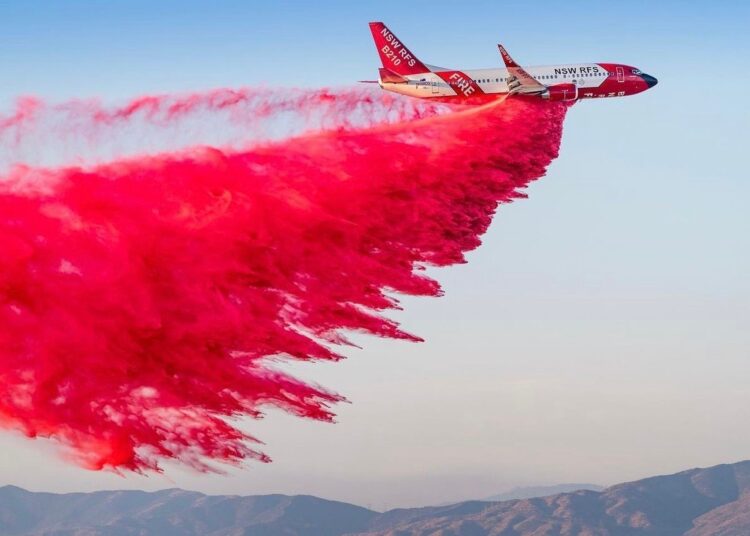By UAFA Staff
The year 2023 is marked by another severe wildfire season, with Canada losing over 30 million acres of land to the flames and Europe aflame. Sadly, lives have been lost in both fixed-wing and rotor-wing firefighting aircraft. The US is always at risk of a similar situation, but the lack of current fires reduces the issue's urgency. This could lead to a lack of preparedness and resources when the fires do occur. Imagine if you decided to close your local fire station, fire its staff, and sell its equipment just because there were no fires in your area this year. That is essentially what the US Government is doing. The aerial wildfire industry struggles to survive as they wait for a contract to cover their costs. Maintaining their aircraft, sought-after pilots and mechanics in a safe and ready condition requires a lot of money, regardless of whether their aircraft fly or not.
Water and retardant-dropping aircraft are vital for wildfire suppression, as they can reduce the fire intensity and protect people and assets from above. However, these aircraft have high operational and maintenance costs and depend on a limited pool of qualified personnel. The National Interagency Fire Center reports that the US has 24 large airtankers, over 200 helicopters, and eight military aircraft for wildfire response, which is much lower than the 100 airtankers and 300 helicopters suggested by a 2012 study. Moreover, only a fraction of these "available" aircraft have secure contracts with the US Government. This means the operators may accept or have already accepted offers from other countries during the fire season to ensure their financial viability.
Most of the costs for operating aircraft in wildfire suppression are fixed, representing about 70% of the total costs. These costs do not depend on the number of flight hours, so the industry must pay them even if the aircraft are unused. Moreover, the industry faces outdated prices due to delays in issuing new contracts. It agreed to supply aircraft as needed at fixed prices in 2018. Since then, its costs have increased by 15% to 20% due to inflation, but its prices have remained unchanged. This poses a financial risk for the industry, especially when the wildfire season is uncertain and variable. For instance, in 2020, the US experienced one of the worst wildfire seasons ever, with over 10 million acres burned. On the other hand, in 2023, the US may have a milder wildfire season because of above-average snowfall and rain in some regions of the West. This implies that the demand for aircraft may be lower than anticipated, leaving the industry with unused assets that still generate costs.
Recently, there have been two significant challenges that have exacerbated the problem. One is the supply chain issues that have affected the global network of suppliers for parts and components. The Covid-19 pandemic, trade wars, and natural disasters have made it harder to get the parts and components needed for the job. Another challenge is the strong labor market that has created more opportunities for pilots and mechanics in other sectors, such as commercial aviation, military, and law enforcement. The industry needs help to keep its existing workforce and attract and train new talent.
The current situation has forced some experienced operators to shrink or leave the wildfire industry, which reduces the government's options and increases the likelihood of coverage gaps. The wildfire industry is essential for safeguarding people, property, and natural resources from wildfires, but it cannot sustain itself under these difficult circumstances without sufficient support from the government and society. The industry requires fair and prompt contracts that account for its actual costs and risks. It also requires incentives and assistance to acquire new aircraft, improve its existing fleet, and train its workforce.
The main issue here is not the lack of federal funds but the allocation and utilization of the existing budgetary resources. The United Aerial Firefighters Association (UAFA) is working to show how a few simple changes can make all the difference. We urge Congress and the agencies to revise the funds' criteria so that there is enough money for the aircraft and its pilots to maintain their readiness. We also recommend streamlining the processes to reduce the administrative burden and increase the efficiency of executing and paying contracts. Moreover, we propose extending the contract durations to enable the industry to invest in the future of wildfire management, access financing for new technology and equipment, and provide their pilots and mechanics with a stable income at a market rate wage.
This is a rare opportunity to solve a public policy problem by addressing some bureaucratic inefficiencies, managing the same budgets differently, and lengthening contracts’ durations. The US cannot afford to be unprepared for wildfires. The stakes are too high. The aerial wildfire industry is ready to do its part but needs help. The time to act is now to secure everyone’s safety better.






